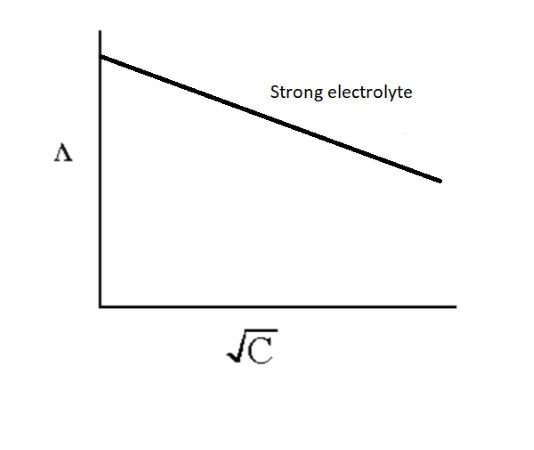
Equivalent conductance for strong electrolyte on dilution _____.
Answer
121.5k+ views
Hint: The conducting power of the ions present in the solution which is formed by dissolving , electrolyte of 1 gram equivalent in a particular solvent is called equivalent conductance.
The equivalent conductance is denoted by \[{\Lambda _e}\].
Complete step by step solution:
Dilution is defined as a process where the solute concentration is decreased with the addition of solvent.
The variations in the value of equivalent conductance depend on the type of electrolyte.
Strong electrolytes dissociate completely into its substituent ions when dissolved in solvent forming a solution. On increasing the dilution (decreasing the concentration of solute), there is the decline in the attractive force present between the cation and anion which further affect there mobility towards each other. This is known as ionic interference. Due to the increase in dilution, the equivalent conductance increases and at infinite dilution, the value of equivalent conductance is highest and it is termed as equivalent conductance at infinite dilution.
Therefore, the equivalent conductance for strong electrolyte on dilution increases.
The effect of electrolyte concentration on the equivalent conductance is observed by the graph plotted between the equivalent conductance value and square root of concentration.
The graph for strong electrolyte is shown below.

Image: Effect of dilution in the value of equivalent conductance
Note: For strong electrolyte, the number of ions remains the same in the solution at all dilutions, the only change observed is the mobility of ions due to the effect of interionic attraction but in the case of weak electrolyte, the increase in the value of equivalent conductance is due to the increase in the number of ions as weak electrolyte possess a low concentration of ions, so the interionic interaction is negligible.
The equivalent conductance is denoted by \[{\Lambda _e}\].
Complete step by step solution:
Dilution is defined as a process where the solute concentration is decreased with the addition of solvent.
The variations in the value of equivalent conductance depend on the type of electrolyte.
Strong electrolytes dissociate completely into its substituent ions when dissolved in solvent forming a solution. On increasing the dilution (decreasing the concentration of solute), there is the decline in the attractive force present between the cation and anion which further affect there mobility towards each other. This is known as ionic interference. Due to the increase in dilution, the equivalent conductance increases and at infinite dilution, the value of equivalent conductance is highest and it is termed as equivalent conductance at infinite dilution.
Therefore, the equivalent conductance for strong electrolyte on dilution increases.
The effect of electrolyte concentration on the equivalent conductance is observed by the graph plotted between the equivalent conductance value and square root of concentration.
The graph for strong electrolyte is shown below.

Image: Effect of dilution in the value of equivalent conductance
Note: For strong electrolyte, the number of ions remains the same in the solution at all dilutions, the only change observed is the mobility of ions due to the effect of interionic attraction but in the case of weak electrolyte, the increase in the value of equivalent conductance is due to the increase in the number of ions as weak electrolyte possess a low concentration of ions, so the interionic interaction is negligible.
Recently Updated Pages
Classification of Drugs Based on Pharmacological Effect, Drug Action

Types of Solutions - Solution in Chemistry

Difference Between Alcohol and Phenol

JEE Main Participating Colleges 2024 - A Complete List of Top Colleges

JEE Main Maths Paper Pattern 2025 – Marking, Sections & Tips

Sign up for JEE Main 2025 Live Classes - Vedantu

Trending doubts
JEE Mains 2025: Check Important Dates, Syllabus, Exam Pattern, Fee and Updates

JEE Main Login 2045: Step-by-Step Instructions and Details

JEE Main Chemistry Question Paper with Answer Keys and Solutions

JEE Main Exam Marking Scheme: Detailed Breakdown of Marks and Negative Marking

JEE Main 2023 January 24 Shift 2 Question Paper with Answer Keys & Solutions

JEE Main Chemistry Online Mock Test for Class 12

Other Pages
NCERT Solutions for Class 12 Chemistry Chapter 6 Haloalkanes and Haloarenes

NCERT Solutions for Class 12 Chemistry Chapter 1 Solutions

NCERT Solutions for Class 12 Chemistry Chapter 2 Electrochemistry

JEE Advanced Marks vs Ranks 2025: Understanding Category-wise Qualifying Marks and Previous Year Cut-offs

NCERT Solutions for Class 12 Chemistry Chapter 7 Alcohol Phenol and Ether

NCERT Solutions for Class 12 Chemistry Chapter 8 Aldehydes Ketones and Carboxylic Acids




